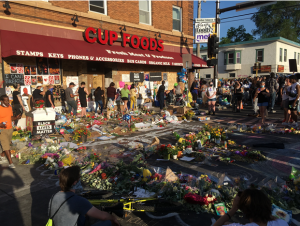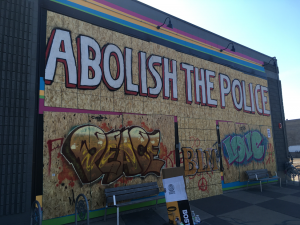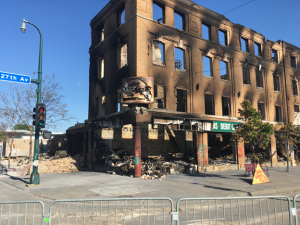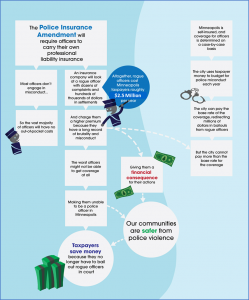
Introduction & Background
In the aftermath of George Floyd’s murder, activists and policy makers are advocating for fundamental reforms to stop police violence. Requiring police to carry their own liability insurance is an idea that has already attracted significant support. Having studied the push for police misconduct insurance in Minneapolis, I can provide some background on both the proposal and the social movement behind it.
For several years, legal scholars have been examining the role that public and private insurers can play in reforming police and increasing accountability in jurisdictions that carry municipal liability insurance—a type of insurance that many small municipalities and some larger ones rely on to some degree. Insurance is a vital system for regulating behavior. For example, municipal-level insurers compel police agencies to adopt policies that reduce misconduct (e.g., amending use of force policies) and can raise premiums in response to violations or deny coverage altogether. Most large cities self-insure, which means that misconduct-related payouts due to civil lawsuits come from city budgets, so their police conduct policies and practices are not affected by private insurers. Because misconduct lawsuits tend to be paid out from a city’s general budget or insurer, police departments, like individual officers, rarely pay. Officers who are repeatedly sued for misconduct are also rarely punished and have little financial incentive to change their behavior. Thus, a central way that police violence and police impunity is perpetuated is through financial immunization of officers.One potential accountability mechanism and alternative means of reducing legal liability for police and municipalities that has been largely overlooked by the public and policing scholars is mandatory individual professional liability (misconduct) insurance for officers. This novel accountability mechanism would work like automobile insurance. Drivers who engage in serious and repeated car accidents have higher insurance premiums. Likewise, officers who engage in grave and repeated incidents of misconduct would have higher premiums. Thus, officers would have financial incentives to avoid misconduct and the increased premiums that they would then have to pay. If a driver has too many accidents, a car insurer can drop coverage, and the driver is no longer permitted to drive. Likewise, if an officer were to commit repeated misconduct, a private insurer could drop coverage. Furthermore, police departments could require officers to carry their own insurance. If they could not get such insurance, police officers, especially repeat offenders, would become unemployable, taken off the streets, and no longer pose a threat to public safety.

In recent years, Minneapolis has been at the center of reform efforts to require police to carry professional liability insurance. In 2016, the Committee for Professional Policing (CFPP), a police accountability group in Minneapolis, Minnesota, attempted to make Minneapolis the first city nationwide to require municipal-level police to carry professional liability insurance. Although a 2016 ballot campaign ultimately failed, CFPP raised national consciousness about this novel, potential reform. In the wake of George Floyd’s death, CFPP leaders—along with other major police accountability groups in Minnesota, including two chapters of Black Lives Matter—have proposed a host of reforms to end police violence, including a renewed push to require officers to carry such insurance.
How Mandatory Professional Liability Insurance Would Work in Practice
An array of funding arrangements are used to cover police misconduct-related lawsuits, and the amount (if any) police agencies and individual officers contribute toward payouts varies by jurisdiction. Large, mid-sized, and small municipalities use three central approaches to satisfy payouts: 1) self-insurance (also referred to as self-indemnification), meaning payouts are made using public funds generated from taxpayer dollars; 2) private insurance, which cities and departments buy from insurance companies; and 3) intergovernmental insurance risk pools, which spreads risk across multiple cities that pay into a membership cooperative. The city of Minneapolis, which has a population of nearly 430,000 people, self-insures, as do many other mid-sized and large US cities.
Self-insured cities, like Minneapolis, would cover the base insurance rate for officers, but officers would be individually responsible for any premium increases due to misconduct, like car insurance premium increases after an auto accident. Officers who continue to engage in misconduct would eventually become uninsurable and, therefore, unemployable since a requirement of employment would be to carry insurance. Mandatory insurance would reduce the financial burden currently placed on taxpayers, especially in self-insured cities. It would challenge the status quo of police impunity by circumventing police union labor protections against officers being fired or reinstated by arbitrators following incidents of grave misconduct, especially rogue officers who repeatedly engage in misconduct. It would also shift discretionary authority from legal actors in the criminal justice system—who rarely punish problem officers—to private insurance companies. Finally, it would incentivize officers to engage in good conduct since private insurers could potentially reward officers who refrain from misconduct with lower insurance premiums similar to how good drivers pay lower premiums than bad drivers.
Increased Police Liability Due to Growing Number of Civil Lawsuits & Large Payouts
In recent decades, legal liability facing cities and police agencies has increased significantly due to police misconduct – and this fact has shaped proposals in Minneapolis and elsewhere. One sign of increased police liability is the rising number of civil lawsuits involving police. From 1980 to 2005, the number of federal court decisions on misconduct-related civil lawsuits filed against police almost tripled. Within these cases, nonsanctioned use of force by officers during arrest and failure to ensure due process are the two most common areas in which citizens typically seek damages and receive settlements.
Another sign of increased police liability is evidenced in the large financial settlements awarded to citizens that successfully sue police, their departments, and municipalities. In recent years, the cost of settling police misconduct cases has increased dramatically in large US cities. In 2014, the ten cities with the biggest police departments paid $248.7 million in police misconduct-related settlements and judgments, which was a forty-eight percent increase from the $168.3 million paid in 2010. Over that five-year period, those cities combined paid $1.02 billion in these cases.
Irrespective of the approach cities employ to cover liability lawsuits (i.e., self-insurance, private insurance, or intergovernmental insurance risk pools), misconduct payouts represent a miniscule portion of these cities’ budgets. Despite this, many cities, especially self-insured ones, are still struggling to pay for liability-related costs. To cover the increasing costs of misconduct, some US cities and counties are issuing or selling what researchers Alyxandra Goodwin, Whitney Shepard, and Carrie Sloan refer to as “police brutality bonds,” and, consequently, entering into long-term debt cycles. In some instances, this is a response to revenue shortfalls following the Great Recession of 2008. For example, from 2008 to 2017, Chicago, Los Angeles, Cleveland, Milwaukee, and Lake County, Indiana borrowed nearly $838 million in police brutality bonds. Banks, firms, and investors that purchased these bonds made over a billion-dollar profit in interest and fees. Consequently, taxpayers in these cities and counties will be obligated to pay a combined total of $1.87 billion.Up until the recent COVID-19 deadly pandemic and global economic depression, the US economy as a whole had recuperated from the 2008 financial crisis, but many governments still struggled with budget problems. Some cities and counties routinely do not budget enough for police liability and regularly shift money from budgets earmarked for education, social services, and infrastructure to cover payouts, or bond borrow, or both. To pay off debts owed to bondholders, some cities use funds from public services, raise taxes, and/or continually issue new bonds, which perpetuates debt cycles. The high costs of payouts have fueled the push for police liability reforms, including holding police departments and individual officers more financially accountable, which some cities, like Baltimore, have taken steps to implement.
How Current Laws Protect Police from Financial Liability
Under current law, officers rarely face financial liability for their actions. Police departments indemnify officers, which means that they provide them with legal representation and assume the costs of judgments and settlements stemming from misconduct that they engage in during the course of their employment. Criminologist Noel Otu was the first academic to propose that municipal-level police be required to carry professional liability insurance. More recently, some police accountability activists, legal scholars, research centers, and think tanks have either recommended that police be required to carry such insurance or that the possibility be further explored.
Misconduct settlements and judgments tend to be paid out from a city’s general budget or insurer, and departments are rarely financially impacted or obligated to help pay for lawsuits. Thus, there is “double indemnification”: both officers and police agencies are indemnified by the city, which covers the cost of settlements and judgments against officers through a general fund. Even in municipalities that hold departments financially liable, such monetary pressures alone will not curb misconduct. Therefore, Schwartz concludes that other pressures are needed to reduce police misconduct, including one that is rarely used but potentially powerful: “to financially sanction individual officers who have violated department policies or the law.” She proposes that municipalities more routinely hold individual officers financially accountable for their misconduct but that municipalities still incur most of the costs stemming from payouts. Putting most of the financial onus on municipalities for the personal liability of their officers spreads risk, safeguards officers from becoming overly cautious while on patrol (i.e., overdeterrence), and makes certain that victims of police misconduct are compensated when their civil rights are violated.
Brief Background on CFPP’s Failed 2016 Ballot Campaign to Insure Minneapolis Police
In 2010, activists from Communities United Against Police Brutality (CUAPB), a grassroots police accountability organization, began a Minneapolis ballot campaign to require police officers to carry their own professional liability insurance. In 2013, they founded the Committee for Professional Policing (CFPP) as a campaign committee to oversee a police insurance amendment (PIA) ballot initiative, which would have amended the Minneapolis City Charter.
Before officially launching the campaign, CUAPB devoted a year to crafting the insurance amendment and built a bipartisan coalition of insurance professionals, labor attorneys, retired police officers, and community stakeholders from across the political spectrum to vet the wording. This diverse coalition thought the PIA would address police misconduct and reduce taxes and government expenditures on misconduct-related payouts. Throughout the campaign, CFPP emphasized the cost savings of requiring such insurance. Their emphasis on cost savings is part of a broader criminal justice policy discourse that has started to dominate political and public debates about criminal justice and prison reform, especially since the 2008 financial crisis. For example, conservatives have increasingly embraced, at least to some extent, cost savings as part of bipartisan efforts to curtail the war on drugs, mass incarceration, sentencing, and prison overcrowding.
The following CFPP campaign infographic explains how the PIA would have worked in practice:
The group collected over 15,000 ballot signatures—well over the 7,000 required to get the measure on the November 2016 ballot. Nevertheless, the campaign failed when the state supreme court upheld a lower court ruling barring the proposed amendment from appearing on the ballot, ruling that it was preempted by and in conflict with several state statutes.
At the time of CFPP’s 2016 campaign, Minneapolis was not yet experiencing a financial emergency due to large financial payouts stemming from police misconduct. Today, however, the situation has worsened, following the murder of George Floyd and the recent record-setting $20 million payout to the family of Justine Ruszczyk (also known by her unofficial married name, Justine Damond). This payout was almost equivalent to the overall amount the city has paid out in misconduct settlements and judgments in the last fifteen years. To cover the Ruszczyk settlement, the city had to deplete most of its self-insurance fund, which currently has a net balance of roughly $25 million. Though the city’s chief financial officer claims that Minneapolis has enough money to cover fluctuations in annual payouts, the Ruszczyk settlement has set a new precedent for future misconduct payouts, and the effects of it are starting to reverberate. Like many other US cities and counties, Minneapolis may have to resort to bond borrowing, which could lock the city into a long-term debt cycle to cover the rising costs of misconduct-related payouts, especially in the aftermath of the recent George Floyd case.
Changing Policing After George Floyd
During and shortly after CFPP’s campaign, lawmakers in Maryland and Chicago proposed similar bills requiring police to carry their own professional liability insurance; however, neither bill passed. This potential accountability mechanism continues to gain traction across the ideological spectrum with libertarian think tanks, like the Cato Institute, supporting it, and some racial justice research centers embracing it as an imperfect but provisional reform mechanism. Most recently, legal scholars have advocated for mandatory professional liability insurance and believe that, at this time, probably the best way for US municipalities to implement such insurance is by following CFPP’s ballot measure approach.

In the immediate aftermath of Mr. Floyd’s death, Minneapolis Public Schools and the Minneapolis Park Board voted to completely sever ties with the Minneapolis Police Department (MPD), while the University of Minnesota also severed major ties. Meanwhile, the state of Minnesota has filed a civil rights charge against MPD to determine whether the department has engaged in a pattern and practice of racist policies in the last 10 years. Recently, the city responded to worldwide outcry by agreeing to prohibit MPD from using police chokeholds and neck restraints. The MPD police chief responded by withdrawing from police union contract negotiations, saying that the contract must be restructured to increase transparency and for transformational reforms to become possible. Recent empirical research by legal scholar Stephen Rushin finds that police union contract negotiations tend to lack transparency, stymie community participation, and hinder accountability efforts. Amid some community protests calling to defund MPD, the Minneapolis community and local government leaders continue to re-evaluate their relationship with MPD, including recent calls by two-thirds of city council members to disband the current force of 878 sworn officers altogether and replace it with a new community-based, non-violent public safety model. Even prior to Floyd’s death, some local community activists were calling to dismantle and divest from MPD. For example, in 2017, a “police-free” association named MPD150 comprised of local organizers, activists, researchers, and artists in Minneapolis conducted a 150-year review of MPD and called to completely abolish the department due to its long history of racism and police brutality.
In an interview for this piece, CUAPB Board Member and CFPP Chair, Dave Bicking, said that while they are sympathetic to MPD150’s vision of a police-free society and recent calls to defund and disband the department, they do not think it is likely to happen nor do they believe that practical substitutes currently exist for some necessary police functions. After years of facing resistance to reform from the city council, CUAPB views current calls by two-thirds of city council members to disband MPD as posturing and pandering to radical activist and community protest demands, as the whole world watches.[i]There are only two ways to amend the city charter. The first way is “by ordinance if passed by the unanimous affirmative vote of the entire membership of the City Council and the approval of the mayor.” However, currently, the city council only has 12-active members out of 13 and, therefore, does not have an “entire membership” present to vote to amend the charter, and the Minneapolis mayor recently stated that he does not support defunding or disbanding the department. The second way to amend is through a ballot measure, such as the one CFPP tried to pass. Theoretically, there is still enough time for ballot measures to be placed on the upcoming November electoral ballot calling to disband the police. But even if MPD were disbanded, there would still be the transit police, University of Minnesota Police Department, park police, and other local police as well as Hennepin County sheriff’s deputies, state troopers, and federal law enforcement officers.
Despite past resistance from Minneapolis public officials, CUAPB still believes that it is necessary to reform MPD and other law enforcement agencies statewide. This is why they released a 24-page document in the wake of Floyd’s death endorsed by other local police accountability groups entitled, “What Will It Take to End Police Violence? Recommendations for Reform” to address police brutality in Minnesota, including a renewed call to require police officers to carry their own professional liability insurance. Floyd’s murder has also galvanized national reform efforts, and several cities, including Los Angeles and New York City, have committed to reduce police budgets and reinvest in public services, especially in communities of color disproportionately affected by police violence. Such efforts are occurring as overpunishing is falling out of favor, violent crime has dramatically declined in recent decades, and criminal justice and community policing are being reimagined in ways that seek to increase public safety and advance racial justice.The innovation of police misconduct insurance by contemporary police reformers seems well-timed, as high law enforcement expenditures are becoming more difficult to justify to the public, and the country continues to demand increased police accountability. Since Minneapolis public officials made it virtually impossible for CFPP to pass a ballot initiative requiring officers to carry individual-level insurance at the city level, CUAPB leaders are currently in talks with state lawmakers to try to mandate individual-level insurance on the state level, as part of their long-term vision and plan to build a nationwide movement to insure police.
Recommended Readings
Goodwin, Alyxandra, Whitney Shepard, and Carrie Sloan. 2018. “Police Brutality Bonds: How Wall Street Profits from Police Violence.” Action Center on Race & the Economy.
McCoy, Candace. 2010. “How Civil Rights Lawsuits Improve American Policing.” Pp. 111-160 in Holding Police Accountable, edited by Candace McCoy, 111-60. Washington, DC: Urban Institute Press.
Otu, Noel. 2006. “The Police Service and Liability Insurance: Responsible Policing.” International Journal of Police Science & Management 8(4): 294-315.
Ramirez, Deborah, Marcus Wraight, Lauren Kilmister, and Carly Perkins. 2019. “Policing the Police: Could Mandatory Professional Liability Insurance for Officers Provide a New Accountability Model?” American Journal of Criminal Law 45(2): 407-60.
Rappaport, John. 2017. “How Private Insurers Regulate Public Police.” Harvard Law Review 130(6): 1539-1614.
Rozema, Kyle, and Max Schanzenbach. 2019. “Good Cop, Bad Cop: Using Civilian Allegations to Predict Police Misconduct.” American Economic Journal: Economic Policy 11(2): 225-68.
Schwartz, Joanna C. 2016. “How Governments Pay: Lawsuits, Budgets, and Police Reform.” UCLA Law Review 63(5): 1144-1299.
Schwartz, Joanna C. 2014. “Police Indemnification.” New York University Law Review 89(3): 885-1005.
Walker, Samuel, and Carol A. Archbold. 2019. The New World of Police Accountability (3rd edition). Thousand Oaks, CA: SAGE Publications, Inc.
[i] Although the Minneapolis City Council may have a two-thirds majority vote, there are practical and legal problems involved in implementing abolition. For example, there are several sections in the Minneapolis City Charter that likely preclude it from happening: 1) Article VII: Section 7.2(a)(7) states that the city council has to provide a police department; 2) Article VII: Section 7.3(a) states that the Mayor has “complete power over the…maintenance…and command of the police department…”; 3) Article VII: Section 7.3(c) states that the “City Council must fund a police force of at least 0.0017 employees per resident” (based on the current census, the city council must fund at least 730 officers); and 4) Article VII: Section 7.3(a)(2) states that “[e]ach peace officer appointed in the police department must be licensed as required by law.” Under Minnesota Statute 626.84, only peace officers who are licensed by the Minnesota Board of Peace Officer Standards and Training are “charged with the prevention and detection of crime and the enforcement of the general criminal laws of the state” and granted the “full power of arrest.”

